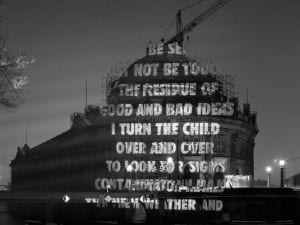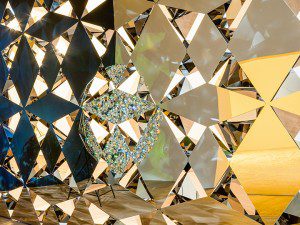The American artist brings contemporary political and social topics into question, highlighting a globalised, fractured and turbulent landscape.
American artist Jenny Holzer’s (b. 1950) red LED installations are instantly recognisable; socially and politically critical, the projected script runs across walls or electronic light boards. “The light is an invitation for people to gather, to think, and to stay in a group whilst thinking. I am enough of a leftover street artist to want things such as blinking lights to draw people – LEDs”, says Holzer. Her work is more prescient than ever. Using text by established poets, such as Anna Świr (Świrszczyńska), Samuel Beckett, and Nobel Laureate Wislawa Szymborska; pronouncements and texts written by her own hand; and declassified US government documents; Holzer focuses on the clash between intention and reality.
Informed by a multitude of literary and political figures, it is her Truisms that really brought her work to the fore. Started in 1977, the Truisms have been displayed in a multitude of places: storefronts, museums, galleries, ancient walls, t-shirts, and the façades of historic buildings. They were the kinds of questions and provocative statements which many people were contemplating but few were brave enough to voice: “An elite is inevitable”; “Class structure is as artificial as plastic”; “Grass roots agitation is the only hope”; and “A lot of professionals are crackpots.” The Truisms were typeset in alphabetical order, inexpensively printed as photolithographs, and distributed and posted anonymously throughout the city. Evocative of British photo-conceptual artist Victor Burgin’s iconic work Possession (1975), a poster which he fly-posted 500 copies of around Newcastle-upon-Tyne, Holzer uses guerilla placement and text as part of her artistic medium. Both Burgin and Holzer draw attention to inequality of class through these works. Burgin’s poster boldly asks: “What does possession mean to you?” and then succinctly stating in reply, “7% of our population own 84% of the wealth.” Moving the political into the street, away from the walls of the conventional gallery, Holzer and Burgin demand public participation through the work’s location.
Originally trained as a painter, Holzer graduated from Ohio University in 1972 and then moved to the Rhode Island School of Design for her Masters and eventually NYC to participate in the Whitney Museum’s Independent Study Program. Completing her MFA in 1977, her practice has been dominated by the use of text, manipulated using various media. She cites Bruce Nauman as an influence for an equally experimental use of media: “He makes whatever he thinks appropriate, I have always wanted to grow up as such.”
Nauman, like Holzer, is recognised for his innovative and provocative artworks but pushes the boundary for audiences through the physical and the psychological rather than the literary and intellectual. Nauman’s infamous work Green Light Corridor (1970) includes a green light that emanates from two towering claustrophobic walls through which the viewer is encouraged to manoeuvre space and light, in much the same way that Holzer subtly uses provocative text. Nauman’s early work was much more like Holzer, having adopted neon signage in the 1960s to illustrate his texts, for example None Sing Neon Sign (1970) and Raw War (1970), but he moved away from these works to explore private architectural space in a way that Holzer never has. Her exploration of light and space would perhaps be more like that of Dan Flavin in this regard, but the use of text is more familiar to that of American contemporary Barbara Kruger. Kruger is often referred to as an “extract expressionist” artist, literally extracting images from widespread news and mass media and overlaying them with text from advertising campaigns, slogans, imperatives and questions, awarding new meaning through bold statements.
We suffer from a constant onslaught of images and texts, and are inundated by advertising, news and media, which we must sift through to find meaning. Kruger, Burgin and Holzer offer us unique ways of doing so; they give us an easy way to understand, but more importantly, analyse. Their work encourages us to find a new way of looking at mass media. Pop art icon Richard Hamilton argued in 1960: “What is needed for the youth of today is that they should be educated in a positive sense towards a complete understanding of the techniques of the mass media, whose products they already know and appreciate.” Not only must we question what media is available but what is not. “Censorship is always a threat”, Holzer qualifies, “I think it’s harder now with social media and various other forms of communication for censorship to be as effective as it once was.” This idea will be one of the key issues raised in the upcoming commission at the Massachusetts Museum of Contemporary Art. The works use the texts of Anna Świr, alongside declassified documents.
Świr’s prose, sourced from the newly translated 1974 publication Building the Barricade, describes the suffering that is a consequence of war. The words unfortunately reveal a reality not dissimilar to that of those involved in current war and conflict, specifically for Holzer, Syria. Prepared in time for Building 6’s opening (the newly-designed addition by architectural firm Bruner / Cott), the texts are projected outside MASS MoCA, along the back of the river-frontage, as well as in LED installations within the building. Text-based light installations have been central to Holzer’s practice since 1996. Concurrent with a movement away from LEDs, her works took on a more sculptural element, moulding to architectural sites rather than dominating them. Holzer’s stone benches, everyday functional objects made of granite, are also inscribed with texts – like the LED, the text merges with the object. Holzer says that she makes benches when she wants to find a certain way to bring text and people together.
MASS MoCA’s buildings provide an extraordinarily hospitable space. A former textile factory in the industrial town of North Adams, Massachusetts, Holzer says that they “are a supportive and anything but distractive home for this activity and content providing a space, shelter, resonance and relevance.” Comparable to what DIA did in New York during the 1970s and 1980s, taking on pre-existing structures and allowing them to stand as shells and sites for the art, rather than building afresh, MASS MoCA is uniquely positioned for site-specific works. Alongside Holzer’s commission will be works by Laurie Anderson, James Turrell, Robert Rauschenberg and Louise Bourgeois. Director Joseph C. Thompson says that the buildings are “big, brawny, American vernacular buildings; they need a certain kind of art that can stand up to the toughness of the space.” Holzer’s work undoubtedly does this, the powerful content which she describes as “attend[ing] to war; wars past and present sadly”, is explored here through the projections and illuminated sculptural forms as well as through the silkscreen paintings.
Moving away from the Redaction Painting series (begun in 2005), Holzer uses declassified US government documents as the source of material, the blacked-out lines of the censored words creating a form of visual poetry. Enlarged and fixed to a canvas, the abstracted results are more reminiscent of Kazimir Malevich: the few scattered words rendered almost meaningless when taken out of their original context. Almost. These haunting paintings include a testimony from the investigation into the death of Afghan prisoner Jamal Naseer as well as US papers focused on the Middle East. Trawling the websites of the National Security Archive, the American Civil Liberties Union, and the FBI, she highlights issues of transparency and privacy through this more conventional medium. Holzer argues that her use of silkscreen on canvas is borne of necessity; “people study and preserve paintings and take them seriously, whereas the information wasn’t always noticed or taken seriously.” Holzer’s paintings are not for the Sunday crowd; they are ambiguously provocative, presenting ideas and facts in a new light, with new connotations, or indeed, for the first time.
This return to traditional media is rooted in Holzer’s fine art training, but it is her childhood which has directly influenced the pioneering vision as we know it today. She explains: “My coming of age in the 1960s and being around during the protests of the Vietnam War has something to do with my practice now. As well as being a child of the 1950s: newsreel after newsreel from the 1940s informed me; as well as war movies where the most awful things were evident to the viewer. I thought, when I was a little kid, ‘How could this happen? Why didn’t people stop it.’ I’m not alone in asking this now.” These questions permeate the commissions on view at MASS MoCA and Blenheim Palace, Oxfordshire.
Working with veterans of more recent conflicts, the commission at Blenheim Palace includes utterances and statements “filling” the interiors. Projected onto medieval tapestries, many of which depict past wars, and audible through the spoken word emitted by speakers, the building takes on an augmented reality. The first woman, and the fourth contemporary artist to be selected for the commission, Holzer transforms this historic baroque edifice into a site of reflection around memory and conflict. With its own complex history built on war and wealth, as a gift from the nation to the Duke of Marlborough for victory in battle during the War of the Spanish Succession, and the birthplace of Winston Churchill, the palace offers a unique site for a public art commission. Joining work from a prestigious line of artists (Ai Weiwei, Lawrence Weiner and Michelangelo Pistoletto), this commission is ultimately distinctive. Weiner, for example, used text to form a commentary on the past of the building, whereas Holzer unites its history to the current political climate. The location, as a tourist attraction, has a broad audience, and, as such, the artist hopes that viewers “attach the appropriate feelings to the knowledge of these conflicts. Having the appropriate emotional response is constructive. I think that language can be that vehicle.”
Andres Serrano wrote, in his infamous letter to the National Endowment for the Arts (1989) after they censored his work Piss Christ: “Debate and dissention are at the heart of our democracy. The only danger lies in repressing them.” Without question, Jenny Holzer’s newest commissions, both at Blenheim Palace and MASS MoCA, reveal rather than repress, and hopefully will fufil their ambition of inciting an emotional and intellectual response. The work demands it.
Niamh Coghlan
MASS MoCA, until 1 May 2025
Blenheim Palace 28 September – 31 December










